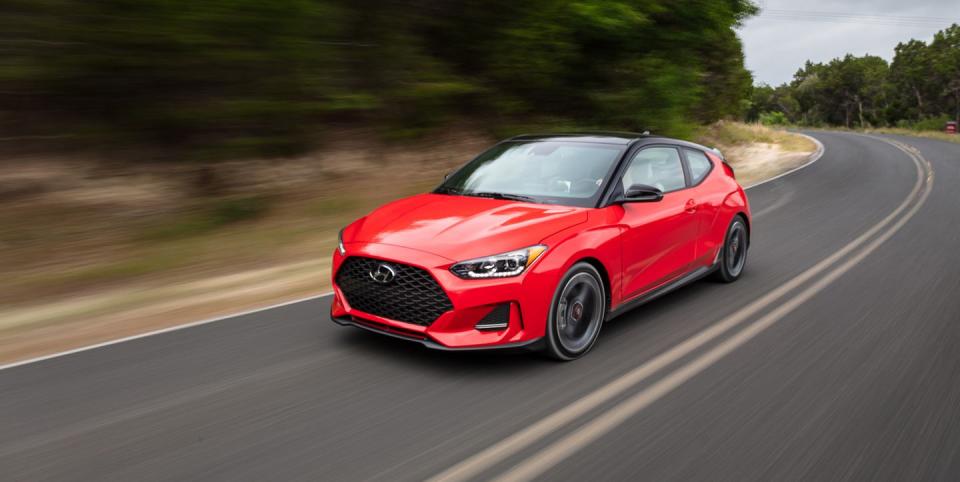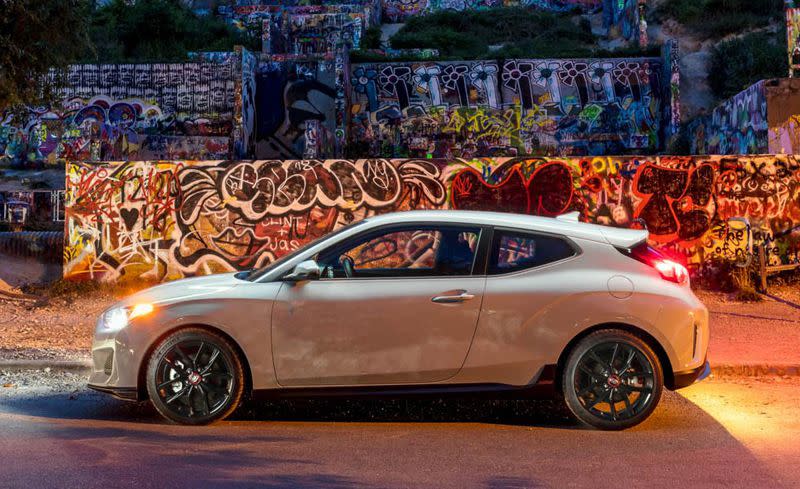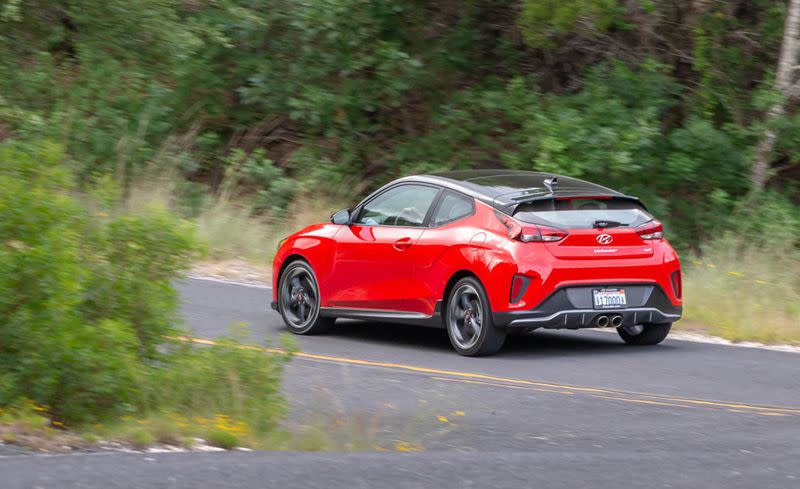The New Veloster Is Still Funky, but It’s Way Better Than Before

As Larry David might say, the 2019 Hyundai Veloster is pretty, prettyyy, prettyyyyyy good. The Seinfeld creator often says this with more than a little sense of relief and an acknowledgment of unexpectedly favorable outcomes for his bumbling travails. Only there really isn’t anything unexpected about the new, second-generation Veloster’s satisfying overall execution.
Hyundai is a couple generations into general competence and long ago became immune to cheap shots like “Hyundais are good, for Korean cars.” More recently, the automaker has grown ambitious about making its mainstream models more appealing to drive. Recently, sizzle has trickled into models as unpretentious as the price-leader Accent sedan and the Kona crossover.
Snap, crackle, and pop have been less discriminatingly meted out to the Veloster. Mechanically similar to the Elantra GT hatchback, the Veloster has a squat, tapered body with pumped-out rear fenders and a commodious, if tight to access, 20-cubic-foot cargo hold. Despite the fact that the redesign sports a faster roofline, Hyundai found more rear headroom-but not reduced blind spots or additional visibility to the rear-by moving the hatch hinges rearward. Materially, the interior is a huge improvement over the old Veloster’s. Hard plastic still abounds, but it’s grained nicely and is impeccably assembled. Simple and clear white-on-black gauges and Hyundai’s ubiquitous touchscreen infotainment system blend into the straightforward, restrained cabin design. Each of the five trim levels is identifiable by different upholstery and pops of color on its seats and dashboard.
And lest we forget, the Veloster still has an asymmetrical layout that places a single, longer door on the driver’s side and a pair of stubbier apertures on the passenger side. The two rear seats can be accessed from either side, but entering from the left requires funneling oneself through the narrow gap between the driver seat and the doorjamb as in a regular two-door coupe. You’ll either like this layout or you won’t, but you won’t find it on any competitor.
Seriously, Forget the Door Thing
Until the high-performance 275-hp Veloster N appears later this year, the Veloster Turbo is Hyundai’s most focused performance machine. With its 201-hp turbocharged 1.4-liter inline-four (carried over from the old Veloster Turbo), firmed-up suspension, and available summer tires, it’s a sort-of competitor to the Volkswagen GTI or the Honda Civic Si. That the Veloster Turbo nearly matches those slightly larger, slightly pricier cars’ specifications is classic Hyundai. We’ll play along, to a point, but we prefer to think of the Turbo as a worthy successor to the half-size-down, soon-to-die Ford Fiesta ST.
There is a base Veloster, which uses a new Atkinson-cycle 2.0-liter engine with port fuel injection, sans turbo, to produce 147 horsepower and 132 lb-ft of torque. We snagged only a quick drive in that one, enough to determine that while the new engine is 15 horses and 12 lb-ft stronger than the 1.6-liter it replaces, it still makes more racket than forward motion when pressed. The upside? The chassis is as well tuned as the Turbo’s, and the two models look nearly identical. Plus, it’s a good deal at $19,385, which includes forward-collision warning, automated emergency braking, lane-keeping assist, cruise control, 17-inch wheels, automatic headlights, and a 7.0-inch touchscreen with Apple CarPlay and Android Auto. A six-speed automatic costs $1000, and it’s standard on the more richly equipped $23,635 2.0 Premium.
Turbo FTW!
The Turbo lineup begins just $150 above the 2.0 Premium with the $23,785 R-Spec, which comes only with a six-speed manual transmission. As far as we’re concerned, the lineup could end there, too. The $26,285 Turbo only can be had with a seven-speed dual-clutch automatic transmission, and although you can order the loaded Turbo Ultimate with a six-speed manual, it’ll cost $27,535. (Equipping a Turbo Ultimate with the DCT adds $1500.) For more on which trim level gets what, read our pricing breakdown of the Veloster lineup; in our book, the R-Spec represents the strongest value.
Every Turbo’s suspension has thicker anti-roll bars and is roughly 15 percent stiffer than the base Veloster’s. The only stick-shift Turbos we drove were R-Specs, which get a trim-exclusive B&M short-shifter kit. The setup’s Honda-like shift quality is shockingly good, and the clutch pedal is springy and progressive with a clear takeup point in the middle of its stroke. Recently, we declared the Accent SE’s manual transmission to be the best Hyundai has ever offered. Transfer that title (with a hat tip to B&M) to the Veloster R-Spec now.
The dual-clutch transmission is less beguiling. Its responses to manual gear selections are disappointingly slow whether you use the steering-wheel paddles or the shift lever, and several times we caught the computers snoozing, leaving us without a complete throttle blip to smooth a downshift. In automatic mode, it upshifts short of redline most of the time to ride the turbo engine’s fat wave of torque in the low and middle ranges. Although not terribly sporty, the protocol feels effective and helps to avoid the shrill whooshing noises and softened thrust that occur near the engine’s redline. The Dyson sound effect isn’t unique in this segment-Honda’s Civic Si is nearly as lacking in high-rpm character-but Hyundai curiously augments it, digitally, through the Turbo’s audio speakers. Every Veloster has Normal, Sport, and (in automatic-transmission models) adaptive Smart driving modes; in the Turbo, these represent different volume settings in addition to changing the steering effort and throttle response. Fortunately, drivers can minimize or shut off the digital exhaust note altogether via the touchscreen.
Handling, by Hyundai?
Before our drive, Hyundai’s vice president of product planning, Mike O’Brien, declared the Veloster’s chassis the best the automaker has ever presented to customers. No hyperbole there. Having traded its torsion-beam rear axle and somewhat flexy body shell for a rear multilink suspension shared with the Elantra Sport models and a stiff new structure, the Veloster is notably more refined and athletic than before, with the sharpest body control of any Hyundai we’ve driven. Chassis response on curvy roads was sublime, and the body never keeled over onto its outside front tire as so many front-drive cars do. The suspension maturely irons out even brutal bumps without transmitting booms or crashes through the body or allowing any float, wheel flutter, or harshness.
The Veloster’s appeal to enthusiasts would be stronger if the handling allowed it to rotate a little more aggressively in tight corners. A different rear anti-roll bar might coax out some friskiness and lift-throttle oversteer like that found in the Ford Fiesta ST. As things sit, the Veloster’s rear end tucks in behind the front nicely when standing on the firm, responsible brake pedal heading into a turn, but it stays determinedly planted.
Stick-shift Turbo models ride on Michelin Pilot Sport 4 summer tires that sink the Veloster’s claws even deeper into the pavement. This serious rubber has more turn-in bite than the Nexen all-season tires found on automatic-transmission Turbos, even sneaking some road feel through the electrically boosted steering rack to the driver’s hands. Every Veloster’s steering is accurate, with a linear buildup of effort as cornering forces increase, a sharp contrast to the previous model’s on-center vagueness and odd surges and dips in steering effort. As a bonus, the Michelins are notably quieter than the all-seasons at speed. Hyundai has so reduced the Veloster’s wind and road noise that it’s easy to pick out the Nexens’ subpar aural signature.
The Skinny, Laid On Thick
If you can learn to love the Veloster’s silly door layout, it’s a blaring deal compared to other sweet-driving compact hatchbacks such as the Mazda 3 or the Honda Civic Sport. The Turbo is a blaring performance deal, and the one we’d buy. In R-Spec guise, the Veloster is a mere $1625 more than the incredibly cramped Fiesta ST (although dealers are marking those down heavily as Ford winds down its car production). Hyundai undercuts the Honda Civic Si by $1210 (or $1410 for an Si with summer tires) and the Volkswagen GTI by $3480. That base GTI, by the way, is only $270 less costly than the full-boat, manual-transmission Veloster Turbo Ultimate. A Hyundai that’s well rounded, stylish, a value, and satisfying to drive-we’re pretty, pretty, prettyyy sure it won’t be the last.
You Might Also Like

 Yahoo Autos
Yahoo Autos 


